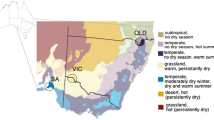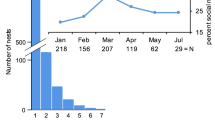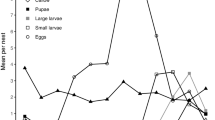Abstract
Several factors thought to be important for the evolution of cooperative breeding in vertebrates have received little attention in facultatively social insects. One of these, the “habitat saturation hypothesis” of Selander (1964), predicts that colony sizes will be greater in breeding units where dispersal opportunities are limited, suggesting that group living is a secondary option to independent reproduction. The Australian allodapine bee Exoneura bicolor exhibits a number of traits that occur in cooperatively breeding bird species, including long life-span, repeated opportunities for reproduction, and vulnerability to brood predation and parasitism. We experimentally examined the effect of a potentially limiting environmental factor, nesting substrate availability, as an agent influencing sociality in E. bicolor. We manipulated nesting substrate availability in two separate locations during a time when foundress dispersal is common. No significant difference was found between colony sizes in cases where dispersal options were abundant and cases where dispersal options were limited. An increase in opportunities for dispersal did not lead to higher rates of independent nesting, suggesting that cooperative nesting is a preferred strategy regardless of distance-related costs of dispersal. Reproductivity per female and brood survival were examined as factors selecting for group living. Low survival of brood in single-female nests has the potential to select for cooperative nesting in this bee.
Similar content being viewed by others
Author information
Authors and Affiliations
Additional information
Received: 29 September 1995/Accepted after revision: 24 June 1996
Rights and permissions
About this article
Cite this article
Bull, N., Schwarz, M. The habitat saturation hypothesis and sociality in an allodapine bee: cooperative nesting is not “making the best of a bad situation”. Behav Ecol Sociobiol 39, 267–274 (1996). https://doi.org/10.1007/s002650050289
Issue Date:
DOI: https://doi.org/10.1007/s002650050289




